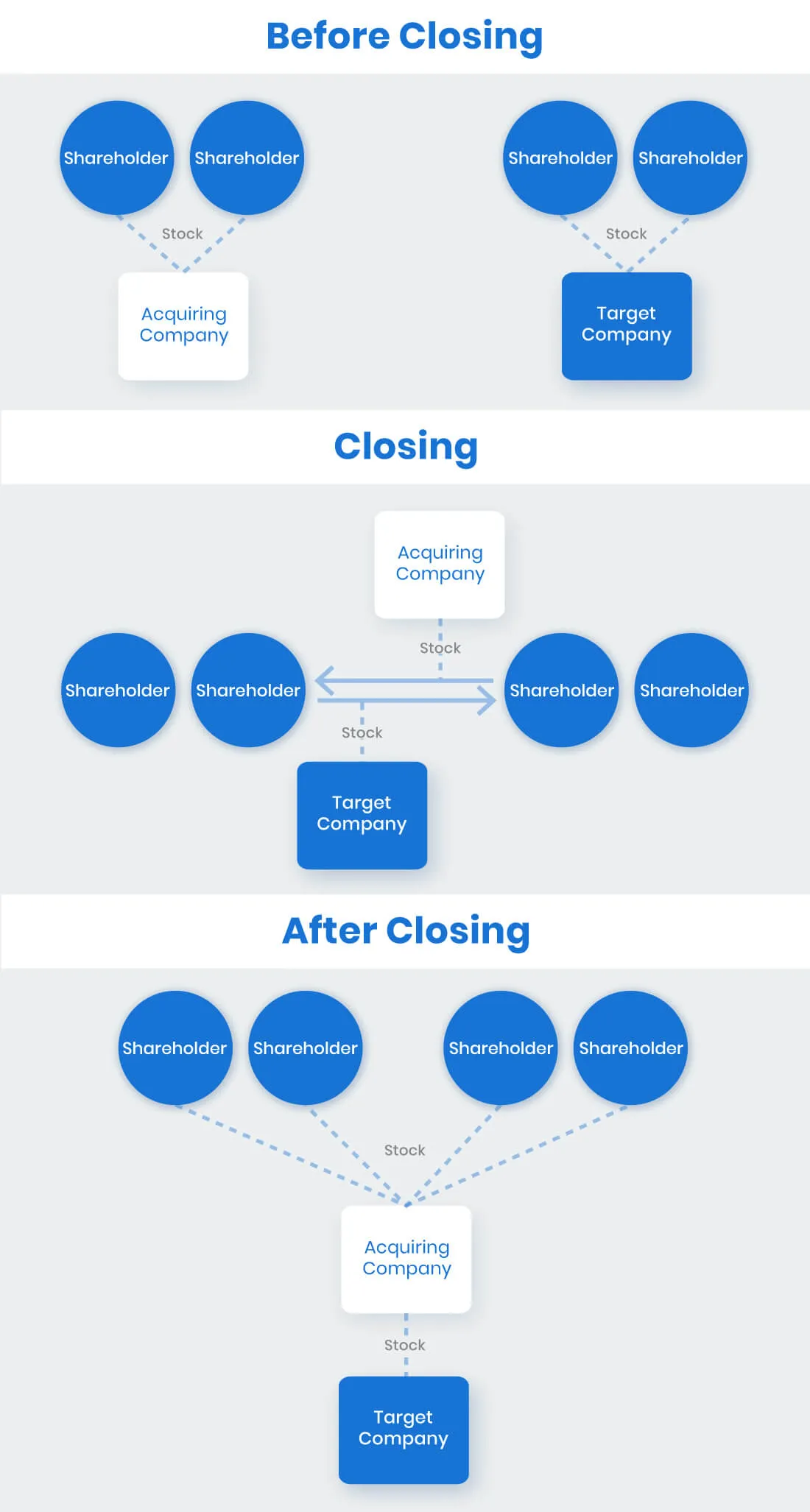The Ultimate Guide to Stock-for-Stock Mergers

.webp)
Stock-for-stock mergers can be an effective way of undertaking transactions without dramatically reducing the cash balance of the acquiring firm or taking on too much leverage - both of which will ultimately destroy value in the transaction.
What is a Stock-for-Stock Merger?
As the name suggests, a stock-for-stock merger is when two companies merge by exchanging stock rather than cash.
If the idea behind stock-for-stock mergers is relatively straightforward, their execution isn’t always; for example, a cash-only deal only involves one valuation.
A stock-for-stock merger requires two.

Dozens of M&A deals are conducted DealRoom M&A platform during a year and in this guide, we will provide a little more understanding of stock-for-stock mergers, some of their pros and cons, and some recent examples as we have some good knowledge in that.
Understanding Stock-for-Stock Mergers
When acquiring a company, broadly speaking there are a few methods to compensate the shareholders of the target company:
- Cash only (usually involving the acquiring firm taking on debt)
- Cash plus stock (of the newly formed company)
- Stock only
Variations of methods 2 and 3 above are termed stock-for-stock mergers.
Essentially, the shareholders of the target company are exchanging their stock for stock in the new company (hence “stock-for-stock”).
As stated in the introduction, this means that not only do both parties have to agree on a value for the target company - which is always the case - but now also have to agree on a value for the company created by the merger.
The companies that agree to the merger achieve this by exchanging their shares for shares in the newly formed company on a pre-agreed ratio.
Advantages and Disadvantages of Stock-for-Stock Mergers
Although it has been said many times, it bears repeating: every deal has its own specifics.
Thus, a stock-for-stock merger may be ideal for some companies, but not for others. Likewise, what’s good for the acquiring company’s shareholders is not always good for the target company’s shareholders and vice-versa.
With that in mind, here are some of the advantages and disadvantages of stock-for-stock mergers:
Advantages:
- Less cash (and debt) can be used in a stock-for-stock merger. Excessive use of cash and debt is often what dooms deals to failure from the start.
- In theory, faster growth can be achieved through stock-by-stock mergers as a company doesn’t have to spend years generating cash before another merger can be undertaken.
- Increased buy-in from the target company shareholders. Giving target company shareholders an interest in the newly formed company succeeding should, in theory, incentivize them to make sure the deal is long-term value generating.
- For the shareholders in the target company, they receive their shares in the newly formed company on a tax-free basis. A taxable gain or loss only occurs when these shares are sold.
Disadvantages:
- Inevitably, there is a relative loss of control for the shareholders of the acquiring company as their percentage holding in the company is diluted by the transaction.
- Stock-for-stock mergers are not a silver bullet: Many of the same issues that dog straight-up acquisitions also affect stock-for-stock mergers. Due diligence (insert link), change management (insert link), managing company culture (insert link) and effective valuation (insert link) are all still issues.
- Stock-for-stock option price satisfaction (that is, the obligation of the acquiring company to satisfy the stock option holders’ their stock option price for the deal to go through) can add significant “invisible costs” to the transaction.
- The more shareholders there are in the target company, the more likely the deal is to run into complications with “hold-outs” being more common in stock-for-stock mergers on balance, because all things being equal, it is easier to convince people to accept cash than to accept stock in a newly formed company.
Examples of Stock-for-Stock Mergers
1. AbbVie and Allergan (2019): $63 billion
The sheer scale of many ‘big pharma’ deals makes stock-for-stock a practical necessity.
When AbbVie acquired Allergan in Q4 2019, it used a combination of its stock and cash to give Allergan shareholders an effective price of $188.25 per share - a 45% premium on their shares’ closing price that day. Less than 2 years later, the stock is now trading at close to double its value at the time of the deal.
2. Verizon and Tracfone (2020): $6.25 billion
Where big deals in the TMT space are concerned, Verizon is rarely far from the action. In Q3 2020, it announced a deal to acquire the prepaid service Tracfone from its Mexican counterpart America Movil.
The deal was composed of $3.125 billion in cash (or exactly half of the total) and the remainder in Verizon stock. The deal thus allowed Verizon to take advantage of the value of its stock, which was trading at close to an all-time high at the time of the deal.
3. Facebook and Oculus (2014): $2 billion
2014 was a year in which all of the big tech firms made transactions in the virtual reality space.
Facebook’s acquisition of Oculus was particularly interesting from one perspective:
It ‘only’ involved $400 million in cash being handed over, with the Oculus shareholders receiving the rest of the transaction fee in stock.
It worked out well for those at Oculus that held onto their shares:
They’re now trading at around 6 times what they were at the time, making this look more like a $10 billion dollar deal for them.
Conclusion
As Facebook’s acquisition of Oculus shows, stock-for-stock deals are not a silver bullet:
Get the valuation of your own company wrong and risk overpaying by a huge amount.
However, let’s forgive Facebook on the basis that most analysts were finding it hard to value at the time.
In most cases, stock-for-stock mergers represent a great way for companies to acquire others without overextending themselves while simultaneously paving the way for higher growth.

Get your M&A process in order. Use DealRoom as a single source of truth and align your team.



.webp)


.webp)
.webp)



.png)
.png)
.png)
.svg)

.svg)
.png)


